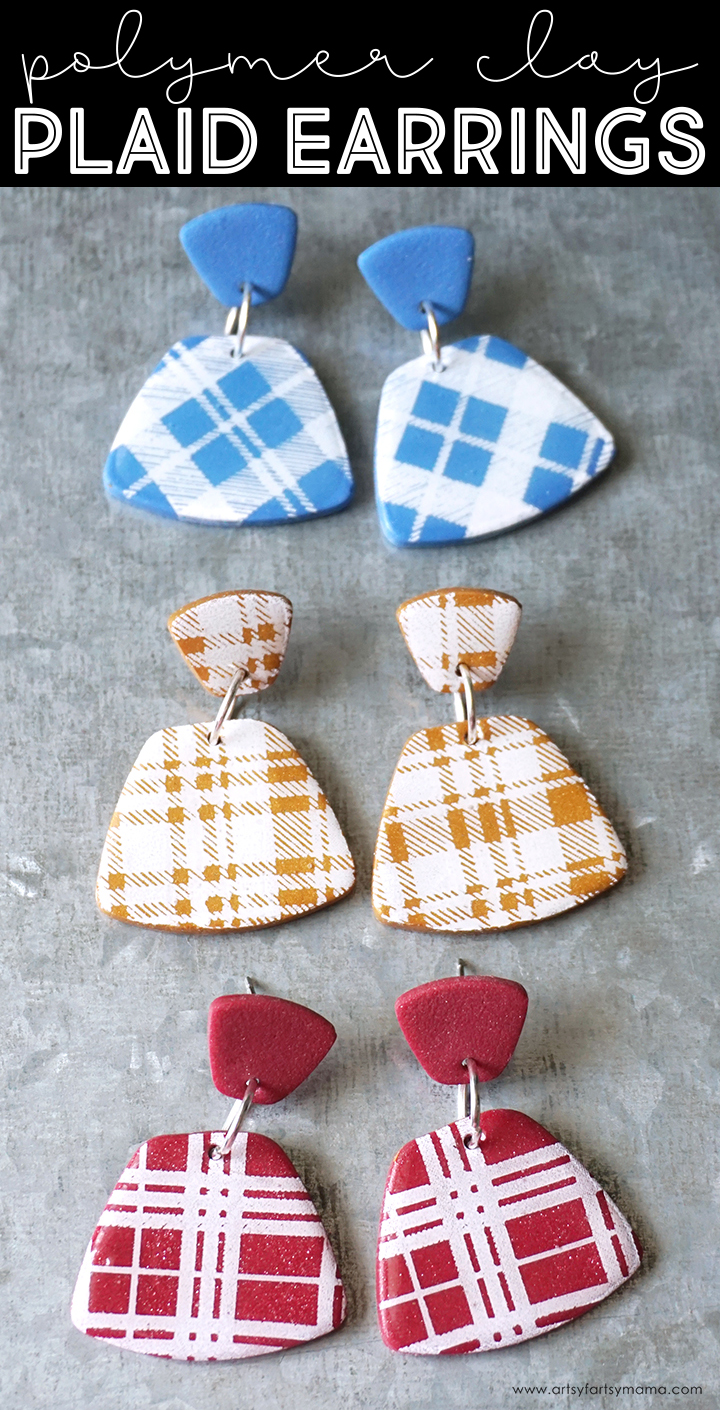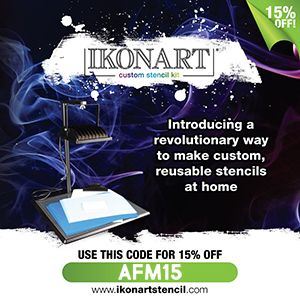Create a stunning pair of Plaid Polymer Clay Earrings using stencils!
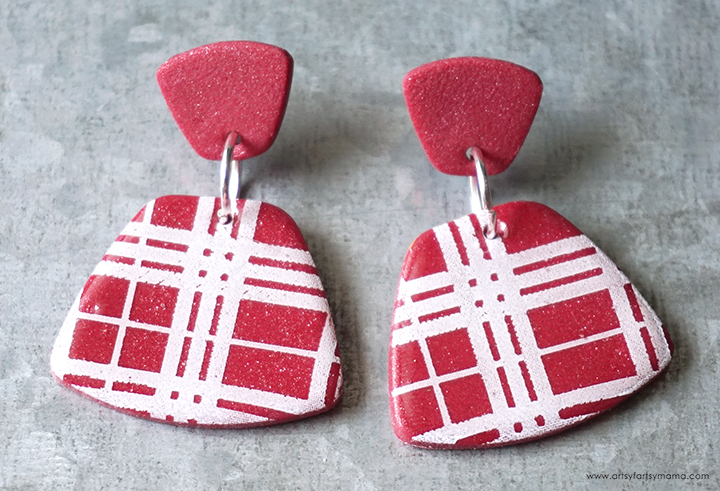

To make your own Plaid Polymer Clay Earrings, you will need these supplies:
- Plaid Patterns Printable (for personal use only)
- Ikonart Custom Stencil Kit
- Sculpey III Polymer Clay
- Baking Mat or Ceramic Tile
- Clay Roller or 2 Craft Sticks
- Acrylic Paint
- Clay Cutters
- Gloss Glaze or UV Resin
- 10mm Jump Rings
- Earring Posts
- Jewelry Pliers
*Save 15% on Ikonart supplies when you shop with code AFM15
The first step in making a stencil with the Ikonart Kit is to print the design. Download the design and print using your favorite printing program on either inkjet or laser Ikonart Printer Film. For best results, make sure to adjust your settings to print as dark as possible.
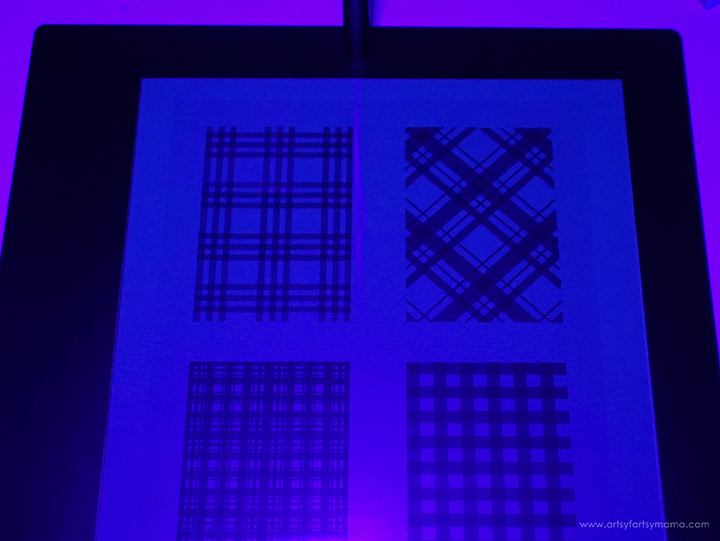
The next step in the process is exposing the stencil film. Set up the Ikonart exposure stand by following the directions included in the kit. Ikonart Stencil Film is light sensitive, so be careful to keep it out of sunlight and bright lights before exposure! Cut the film to the same size or slightly larger than the design print.
Lay the piece of film down on the base of the stand with the textured side facing up. Place the printed design on top of the stencil film.
Lastly, place the clear exposure sheet (found in the stencil film pack) on top and press it down well to seal the design tight against the stencil film. Turn the exposure light on and expose the film for 35 seconds.
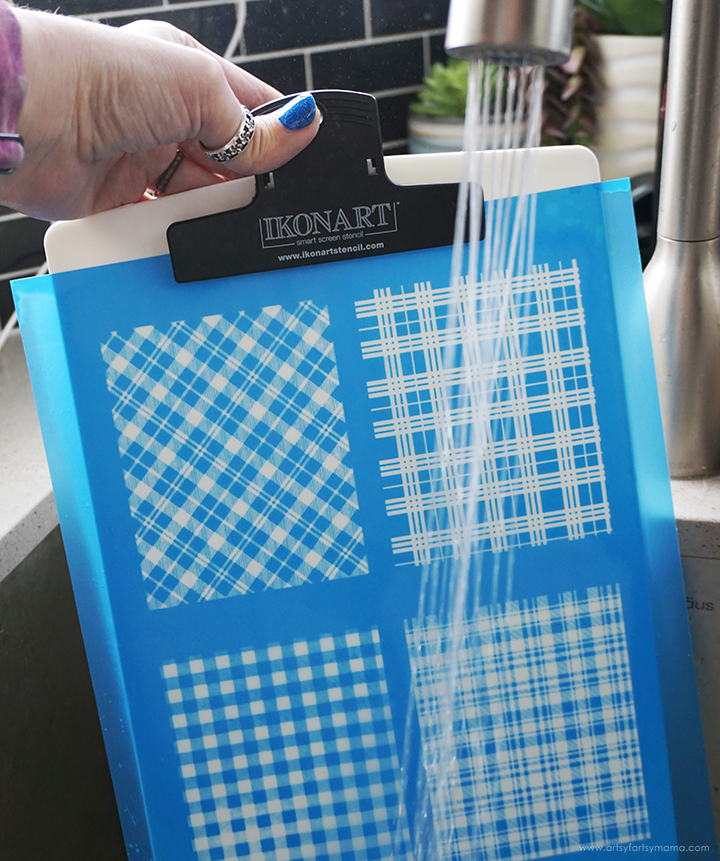
The final step in the stencil-making process is to washout, or rinse, the stencil. Clip the exposed stencil film to the Ikonart clipboard with the shiny side (carrier sheet) touching the clipboard. Use a kitchen sink sprayer to rinse the stencil film with warm/hot water until the design shows through and becomes completely clear. The washout process shouldn't take more than 3 minutes.
Gently blot any excess water off the stencil, and hang or lay flat to dry for about 45 minutes. When the stencil is dry, you shouldn't see any water spots or discoloration. Once dried, place the stencil back on the exposure stand and expose it again for at least 2 minutes. This extra exposure time will increase the durability of the stencil so you can get as much use out of it as possible.
Use a permanent marker and write "back" on the carrier sheet (shiny side) on the back of the stencil.

Take one section of polymer clay and knead it well to get it into a smooth, pliable texture. Use a clay roller with 3mm thickness rings or line 2 craft sticks parallel to each other with the clay in between. Flatten the clay into a large rectangle.
Tip: If you work directly on a baking mat or ceramic tile, you don't have to worry about transferring your project when it's time to bake the clay. This also helps reduce the chances of you dropping or ruining your project in the process.
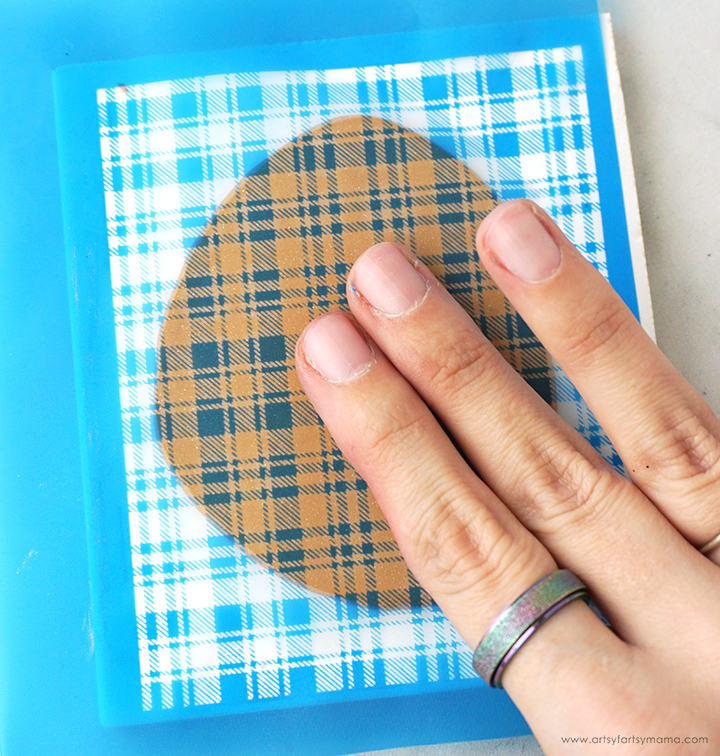
Remove the carrier sheet from the back of the stencil and place it over the clay. Rub it down gently with your fingers or use the roller to make sure it is pressed down well and that there aren't any air bubbles.

Add a small line of acrylic paint at the top edge of the stencil. Use a squeegee to gently pull the paint down to the bottom edge. Don't press hard, just skim over the top of the stencil. Scrape the excess paint away and put it back into the paint bottle.

Slowly lift the stencil up, starting at one side, to reveal that paint below. If you see any spots that you may have missed while peeling the stencil away, carefully lay the stencil back down and add a little more paint over the area.
If everything looks good as you get to the end, remove the stencil completely. Let the paint dry before moving on to the next step (it doesn't take long).

Cut out a top and bottom piece using creatively shaped clay cutters or freehand with a craft knife. Place the cutter over the clay and gently press it straight down. Gently pull the cutter straight up. If the clay stays down, leave it there. If it comes up with the cutter, be careful how you remove it. Poking through the top to push the clay out will leave dents or holes in your work.
Here's a few tricks & tips for cutting clay that have worked for me:
- Place a piece of plastic wrap over the clay first, and then cut the clay.
- Your clay or workspace might be too warm. Put the clay in the fridge or freezer to cool it down before cutting.
- This one is a bit strange, but you can put your mouth over the cutter and blow to set the clay free!
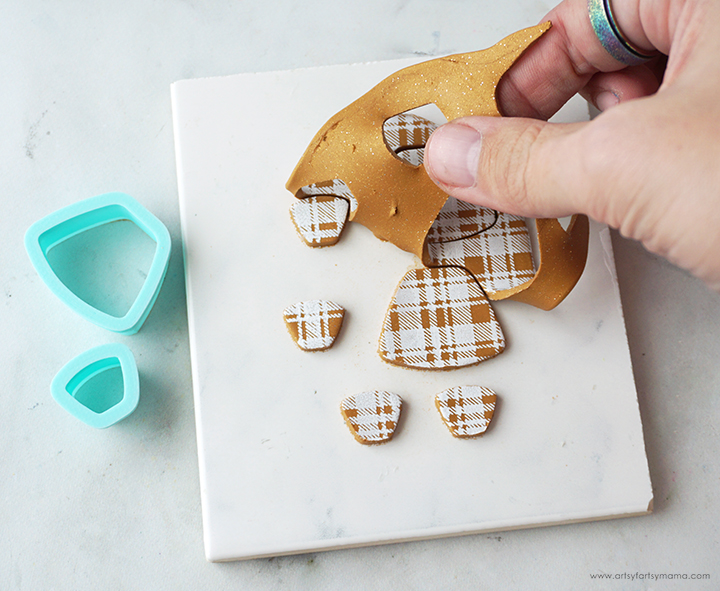
Carefully peel away the excess clay and leave the earring pieces in place. It's ok if the edges of the earrings look a little rough. Just make sure to remove all of the excess clay from around the earring pieces.

Use a toothpick or a small circle cutter to make holes in the earring pieces to easily connect them later.
Preheat your oven and bake the earring pieces. Most polymer clays are usually baked at 275º for 15 minutes per quarter inch thickness, but refer to your specific clay packaging directions to make sure. Once baked, let the pieces cool completely before handling.

Use a fine sandpaper to clean up the edges of the earring pieces. To give the earrings a shiny and professional-looking finish, apply a coat of gloss glaze or UV Resin to the surface with a toothpick.
If using glaze, apply it to the clay in thin coats (30 minutes between each coat). Give the earrings 24 hours to dry completely.
If using UV resin, apply a thin coat over the earrings, and cure under a UV light according to package directions.
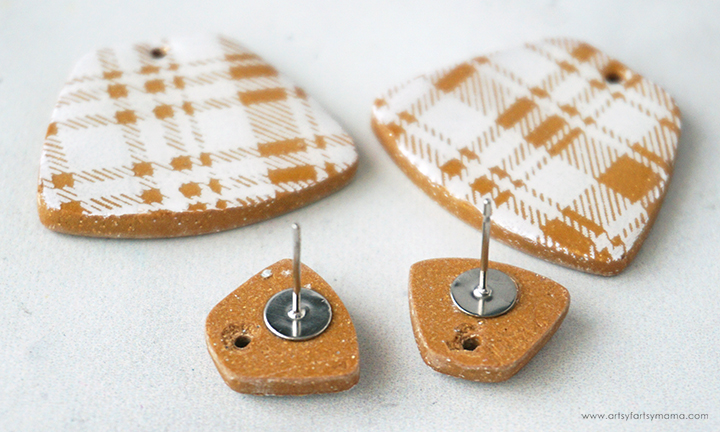
Turn the top earring pieces over, and attach an earring post to the center using strong adhesive or UV Resin.
Use pliers to open a 10-12mm jump ring for each earring. Hook the rings through the holes in the earring sets. Close the jump rings with the pliers.

I love how this pair of gold/tan plaid earrings turned out! They have a bit of sparkle when the light hits them, and they are the perfect color for fall fashion!
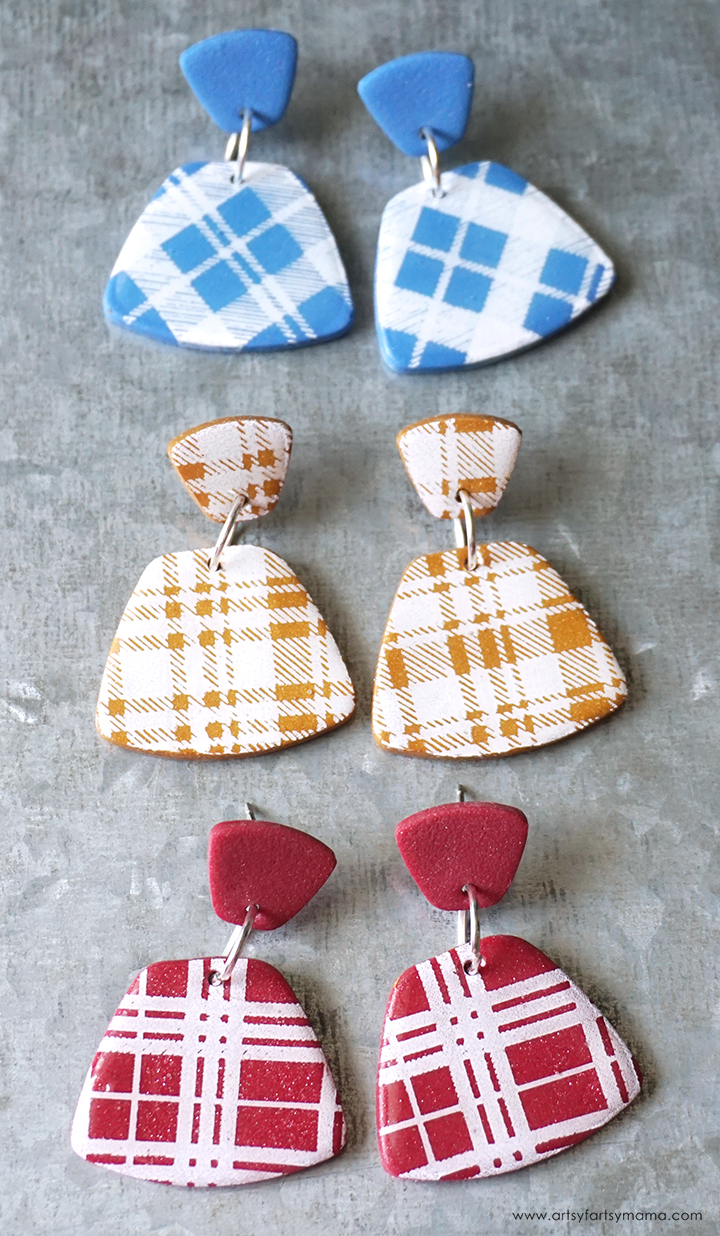
There are so many ways to customize these earrings using Ikonart stencils to fit your style with different shapes, colors, and sizes. Not only are these earrings great for adding a pop of color to your wardrobe, but they would make such great gifts! If you try making some Plaid Polymer Clay Earrings, I would love to see them! Leave me a comment, or tag a photo on Facebook, Twitter, or Instagram! #AFMcrafts
Don't forget to Pin, Like, and Share!
